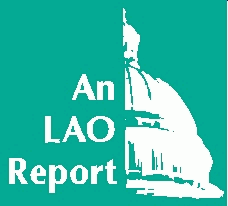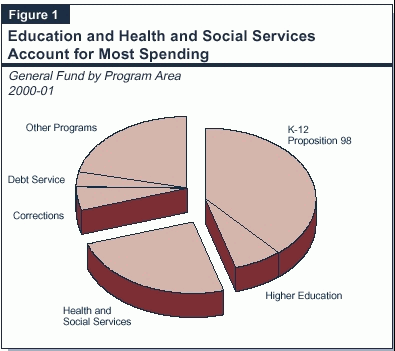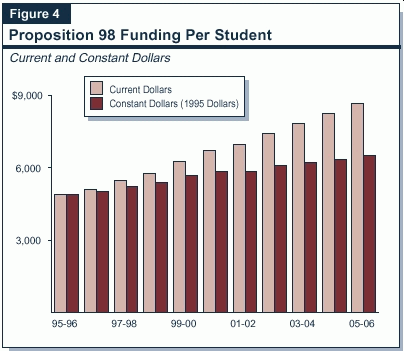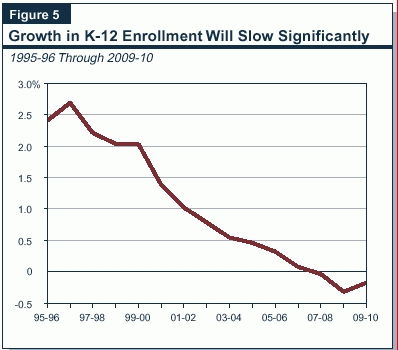
 |
California's Fiscal OutlookLAO Projections2000-01 Through 2005-06 |
In this chapter, we discuss our General Fund expenditure projections for 2000-01 through 2005-06. We first look at general budget trends during the forecast period, and then discuss expenditure projections for each of the major program areas in more detail.
Figure 1 shows how General Fund spending is distributed among major programs in 2000-01. Slightly less than half of the total is devoted to education spending, of which 36 percent is for K-12 Proposition 98 and about 10 percent for higher education. Slightly less than one-fourth of the budget is for health and social services, and about 5 percent is for corrections. The remainder is for state operations, debt service, various local subventions (including the vehicle license fee [VLF] backfill), and other purposes.

Total General Fund Spending. Figure 2 (see page 22) presents our General Fund spending forecast by major program area through 2005-06. Total spending is projected to increase from $67.1 billion in 1999-00 to $79 billion in 2000-01. Over the full forecast period, General Fund expenditures are projected to increase at an average annual rate of about 6.9 percent per year, rising to $99.9 billion by 2005-06.
| Figure 2 | ||||||||||
| Projected General Fund Spending for Major Programsa | ||||||||||
| (Dollars in Millions) | ||||||||||
| Actual |
|
Estimated |
|
Projected | Average Annual Growth 1999-00 Through 2005-06 | |||||
| 1999-00 | 2000-01 | 2001-02 | 2002-03 | 2003-04 | 2004-05 | 2005-06 | ||||
| Education programs | ||||||||||
| K-12--Proposition 98b | $25,081 | $27,334 | $28,302 | $30,116 | $31,766 | $33,459 | $35,194 | 5.8% | ||
| Community college--Proposition 98 | 2,412 | 2,678 | 2,772 | 2,950 | 3,112 | 3,278 | 3,448 | 6.1 | ||
| CSU | 2,208 | 2,416 | 2,538 | 2,691 | 2,849 | 3,014 | 3,187 | 6.3 | ||
| UC | 2,627 | 3,106 | 3,177 | 3,355 | 3,535 | 3,723 | 3,918 | 6.9 | ||
| Health and Social Services | ||||||||||
| Medi-Cal benefits | $7,574 | $8,715 | $9,751 | $10,627 | $11,465 | $12,315 | $13,217 | 9.7% | ||
| CalWORKs | 1,977 | 2,077 | 2,107 | 2,104 | 2,036 | 2,081 | 2,351 | 2.9 | ||
| SSI/SSP | 2,508 | 2,623 | 2,783 | 3,008 | 3,200 | 3,391 | 3,601 | 6.2 | ||
| Other major programs | 5,010 | 5,812 | 6,314 | 7,027 | 7,692 | 8,417 | 9,211 | 10.7 | ||
| Department of Corrections | $3,977 | $4,192 | $4,275 | $4,405 | $4,646 | $4,867 | $5,089 | 4.2% | ||
| Vehicle license fee subventions | $1,287 | $3,614 | $2,442 | $3,856 | $4,122 | $4,407 | $4,711 | 24.1% | ||
| Debt servicec | $2,530 | $2,730 | $2,941 | $3,053 | $3,178 | $3,318 | $3,402 | 5.1% | ||
| Other programs/costs | $9,865 | $13,690 | $10,243 | $10,603 | $11,141 | $11,896 | $12,563 | 4.1% | ||
| Totals | $67,055 | $78,986 | $77,646 | $83,795 | $88,741 | $94,166 | $99,892 | 6.9% | ||
| a Detail may not total due to rounding. | ||||||||||
| b Projections for K-12 and community college Proposition 98 funding have been apportioned by the same percentages as actual funding in the 2000-01 Budget Act. | ||||||||||
| c Includes both general obligation and lease-payment bonds for all departments. | ||||||||||
Projections by Program Area. The overall 6.9 percent increase in state spending reflects divergent trends among the General Fund's major programs. As indicated in Figure 2:
State spending for K-14 education (K-12 schools and community colleges) is determined largely by Proposition 98 passed by the voters in 1988. Proposition 98 sets the minimum amount that the state must provide for California's public K-12 education system and the California Community Colleges (CCC). About 80 percent of operations funding for these school programs is from the state General Fund and local property taxes, pursuant to Proposition 98. Public K-12 education is provided to about 6 million students--ranging from infants to adults--through over 1,000 locally governed school districts and county offices of education. The CCC provide instruction to about 1.6 million adults at 107 colleges operated by 72 locally governed districts.
The Spending Forecast. We estimate that annual growth in total Proposition 98 spending (General Fund and local property taxes) for K-14 education will be near 6 percent for the 2000-01 through 2005-06 period. This is lower than the 10.9 percent increase in 1999-00 and the projected increase of 8.7 percent for the current year. Proposition 98 spending in these two years reflects appropriations above the minimum guarantee. For these two years, the cumulative appropriation above the guarantee is about $2.3 billion, which raises the Proposition 98 base for all future years. Our forecast reflects our moderate revenue forecast and future spending at the minimum guarantee level.
For 2001-02, we estimate that Proposition 98 will require the Legislature to spend at least $2.1 billion, or 4.9 percent, more on Proposition 98 programs than in the current year. This estimate assumes a so called "Test 3-B" scenario (where annual growth in the funding guarantee is based on growth in per capita General Fund spending). The provisions of Proposition 98 would require additional spending of approximately $1.5 billion in subsequent years eventually to restore funding levels to a higher, "Test 2" level (where annual growth is based on the change in per capita personal income). Funding at the minimum level in the budget year would cover the cost of enrollment growth, COLAs, and annualizing program funding that phases in during the current year, leaving little or nothing for new programs or program expansions.
Key Forecast Factors. General Fund expenditures for Proposition 98 depend on the following factors: state population, K-12 average daily attendance, per capita personal income, per capita General Fund revenues, and local property taxes. Figure 3 summarizes our assumptions for these factors and the guarantee which results. Our economic forecast assumes state tax revenues will grow by about 7 percent annually over the forecast period.
| Figure 3 | ||||||
| The LAO Proposition 98 Forecast | ||||||
| Annual Percent Change | ||||||
| 2000-01 | 2001-02 | 2002-03 | 2003-04 | 2004-05 | 2005-06 | |
| State population | 1.8% | 1.6% | 1.5% | 1.5% | 1.5% | 1.5% |
| K-12 average daily attendance | 1.5 | 1.1 | 0.8 | 0.5 | 0.5 | 0.3 |
| Per capita personal income | 4.9 | 7.3 | 4.9 | 4.9 | 5.3 | 5.2 |
| Local property taxes | 7.4 | 8.2 | 7.4 | 6.9 | 6.8 | 6.7 |
| Proposition 98 guarantee | 8.7 | 4.9 | 6.7 | 5.9 | 5.8 | 5.7 |
K-12 Funding Projections. Figure 4 displays our projected K-12 per-pupil spending from 2000-01 through 2005-06 (in both "current" and inflation-adjusted dollars). These estimates, which are derived from our Proposition 98 forecast, reflect real (that is, inflation adjusted) per-pupil increases averaging 2.6 percent each year between 2002-03 and 2005-06. These additional resources--averaging over $900 million each year--would permit expansion of existing programs and/or funding for some new programs. As noted above, however, funding at the Proposition 98 minimum guarantee in 2001-02 would leave little or nothing for new programs or program expansions.

"Freed-Up" Proposition 98 Funds. Within the amounts that we have forecast for Proposition 98 is a total of $600 million that will be available each year for reallocation to other K-14 education purposes beginning in 2002-03. This amount includes $350 million that is currently allocated to a loan repayment relating to the CTA v. Gould lawsuit. Another $250 million will become available due to the sunset of the Schiff-Bustamante Instructional Materials Program (Chapter 312, Statutes of 1998 [AB 2041, Bustamante]).
Slowing K-12 Enrollment Growth. K-12 enrollment is projected to increase by just over 1 percent in 2001-02, bringing total K-12 enrollment to 5.9 million students. As Figure 5 (see page 26) shows, over the next eight years the rate of K-12 enrollment growth is expected to slow, then actually turn negative by 2008-09. During this period of slow growth and eventual enrollment decline, the Legislature would be able to increase per-pupil funding without expanding K-12 education's share of the state budget.

Community College Funding Projections. Based on our Proposition 98 projections, we estimate total CCC funding would increase by about 6.1 percent per year over the forecast period. (This assumes no change in the proportion of Proposition 98 funds going to the CCC.) These increases would cover inflation and projected enrollment growth, with little or nothing available for new programs or program augmentations.
In addition to community colleges, the state's public higher education system includes the UC and the CSU. The UC consists of eight general campuses, one health science campus, numerous special research facilities, and a planned tenth campus in Merced. The UC awards bachelor's, master's, and doctoral degrees, as well as various professional degrees. The UC has primary jurisdiction over research. The CSU consists of 22 campuses, several off-campus centers, and a planned campus at Camarillo. The CSU grants bachelor's and master's degrees and may award doctoral degrees jointly with UC or a private university.
The Spending Forecast. We estimate that spending for UC and CSU (excluding funding for capital outlay and debt service) will increase from $5.5 billion in 2000-01 to $5.7 billion in 2001-02, or by 3.5 percent. (This relatively low increase is due to high one-time expenditures in 2000-01.) By 2005-06, we estimate that spending for UC and CSU will increase to $7.1 billion, reflecting annual increases of about 6 percent.
Key Cost Factors. For 2001-02 and subsequent fiscal years, we assume that UC and CSU will receive "base" budget increases equivalent to the growth in inflation and enrollments. Over the forecast period, inflation is projected to average about 3.1 percent annually. With regard to enrollment growth, CSU's will vary between 2.5 percent and 3 percent over the period, with UC's growth being somewhat less each year.
In his "partnership" with CSU and UC, the Governor has committed to annual General Fund base adjustments of 5 percent plus funding for enrollment growth. The Legislature has not endorsed such automatic funding increases. Our projections for the CSU and UC budgets are lower than would occur under the partnership.
Cal Grant Increases. Chapter 403, Statutes of 2000 (SB 1644, Ortiz), significantly expands the Cal Grant program. There is much uncertainty as to the fiscal impact of the measure. This is because it is unclear how students and their families will respond to the changes in Cal Grant policies. Based on information from the Student Aid Commission, however, Cal Grant expenditures could reach over $1 billion by 2005-06.
Proposed Special Education Mandate Claim SettlementThe Governor recently announced that his administration had reached a settlement agreement with school districts that had filed claims for the cost of certain special education programs. The settlement agreement would end a 20-year-old lawsuit in which districts alleged that the state mandated eight special education activities in excess of federal requirements without providing necessary funds. The major provisions of the settlement include a $270 million one-time payment to local education agencies in 2000-01, a series of one-time payments of $25 million per year for ten years starting in 2001-02, and $100 million of ongoing payments for special education beginning in 2001-02. The settlement's potential effect on Proposition 98 funding requirements is uncertain. It would depend on specific funding steps taken by the Legislature in response to the proposed settlement as well as other actions the Legislature might take regarding Proposition 98 spending. For purposes of calculating a minimum Proposition 98 funding level for this report, we did not include any provision for the settlement. We would note that how payments are structured under a settlement would have varying implications on the guarantee for 2001-02 and beyond. The settlement will not take effect unless 85 percent of the local education agencies, representing at least 92 percent of statewide K-12 attendance, sign off on it. It also will require the approval of the Legislature. The Legislature has options with respect to the settlement's parameters, including the option to modify or delete the eight state mandates in lieu of the $100 million annual payments. |